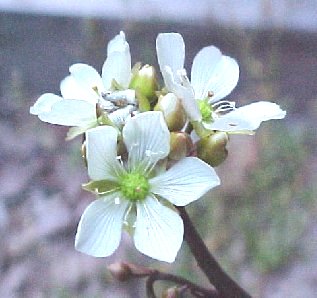GROWING INSTRUCTIONS FOR
VENUS FLY TRAP (Dionaea muscipula)
by Dan Hodgson
Background Information:
Venus fly traps can be moderately easy to grow if certain conditions
are met and maintained. As venus fly traps grow they develop long root
systems, if the plant is healthy, so a tall pot should be used with older
plants. Some believe that a venus fly trap needs to be grown in a pot covered
in plastic or glass, as is commonly seen in nurseries. The truth is that
this will lead to overheating and shriveling, caused by that type of covering,
resulting in poor, weak and spindly growth. Plants sold in nurseries are
often planted in too small of a pot and in the wrong soil type. Typically,
you should re-pot your venus fly trap into the correct soil and a 4 or
5 inch pot. Many beginning growers will overreact to a venus fly trap losing
one of its traps. However, this is normal. The trap is the plant's leaf
and periodically the plant will lose a leaf. If you are growing your venus
fly trap in an area where it does not have access to a natural diet, such
as a terrarium, you may give it one or two flies or pet store/caught crickets
every month. You should not play with the traps (causing the trap to close
with your finger), as this drains the plant's energy . If you play wiith
a trap several times it will become less sensitive and probably die. Although,
this does not hurt the entire plant. If a leaf dies you should always cut
off the dead growth. Maintaining the plant, so fungus does not begin to
grow on the dead leaves.

Conditions:
-
Light -- Light should be of full sun quality and brightness.
-
Soil -- Sphagnum or peat moss usually make the best soil. These
can also be mixed with a little silica sand and/or orchid bark. Some growers
add charcoal to remove salts that are present.
-
Humidity -- The Venus Fly Trap doesn't require extremely high humidity,
but above 50%.
-
Temperature -- Can range from 70° - 95° F (21° - 35°
C) and down to 40° F (5° C) in the winter.
-
Water -- Rain water or distilled water is preferred. Keep the plant
damp, but not soaking. Many growers keep a pan beneath the pot with about
an inch of water in it to keep humidity around the plant high and to keep
the plant consistantly moist.
Other Factors: 
Dormancy -- Venus Fly Traps need a dormant period in the winter.
This period usually lasts about 3 months. As a venus fly trap enters its
dormant period, the tall large growth on it will die, leaving a few small
leaves or even just its bulb and root system. Be careful not to mistake
this for a dying plant. Many will throw away a venus fly trap entering
dormancy for this reason. During this period the temperature should be
lowered to between 45 F (8 C) and freezing. To acquire this temperature
some growers may need to store the plant in a basement or a garage, depending
on the grower's geographic location/climate. If the plant is stored in
the garage or basement, the plant will need to be treated with fungicide,
wrapped in damp sphagnum moss and placed in a plastic bag for prevention
of fungus. Check the plant regularly to confirm no fungus is growing on
the plant. Be sure to keep the venus fly trap from becoming too wet duringdormancy,
as this will cause the plant to rot.
Fun Links:
-
North Dakota State University- NDSU
-
International Carnivorous Plants Society - ICPS
pictures courtesy of: Matt Miller, Carnivorous Plants Online 2002.


